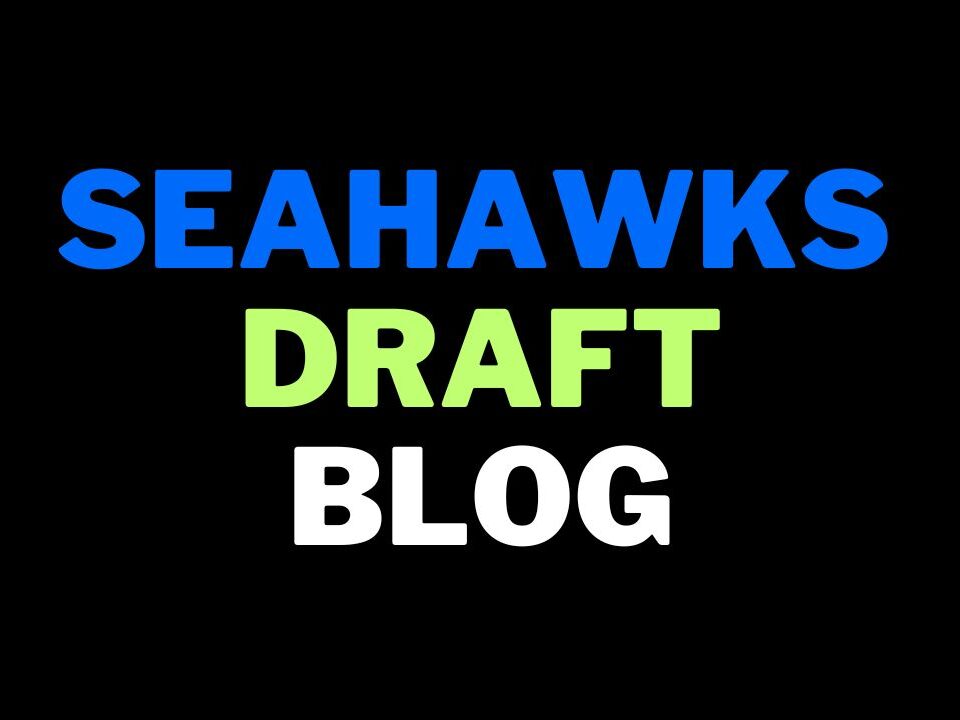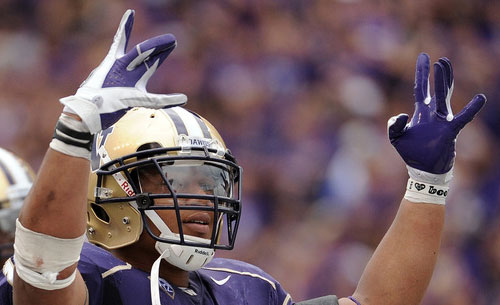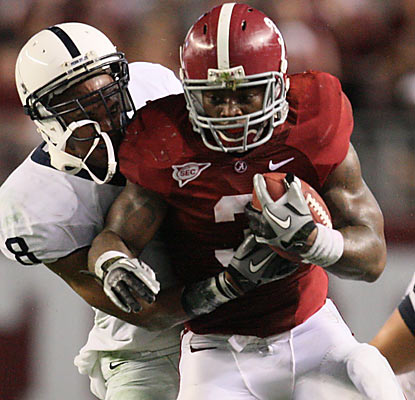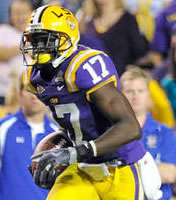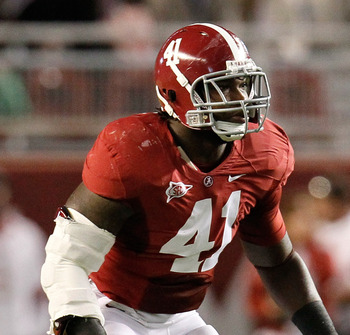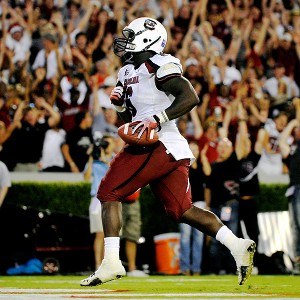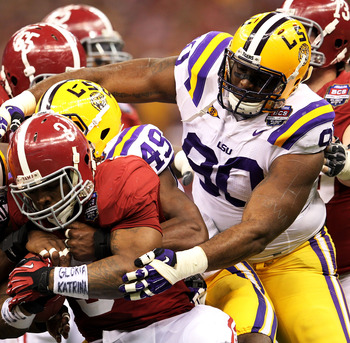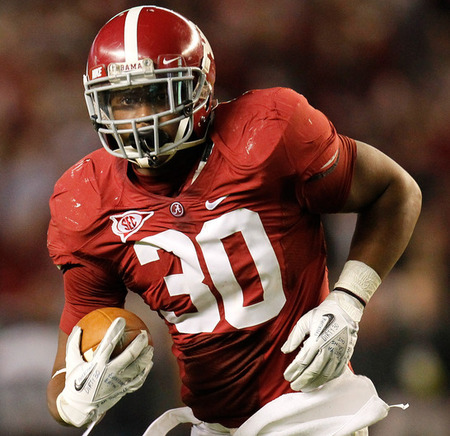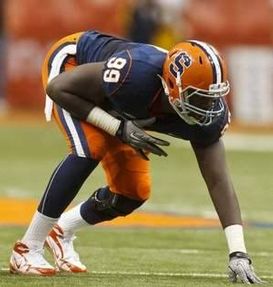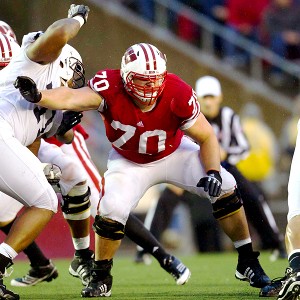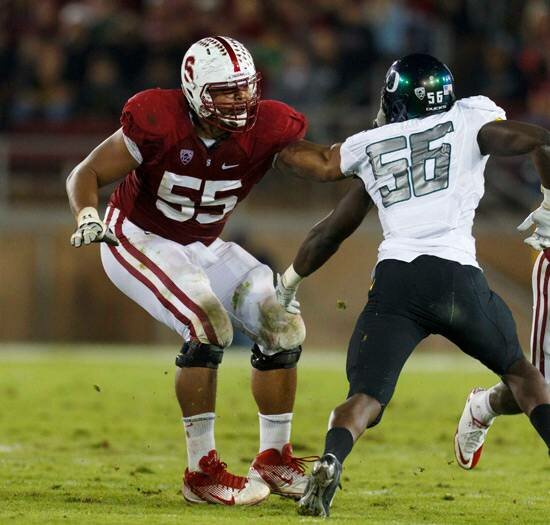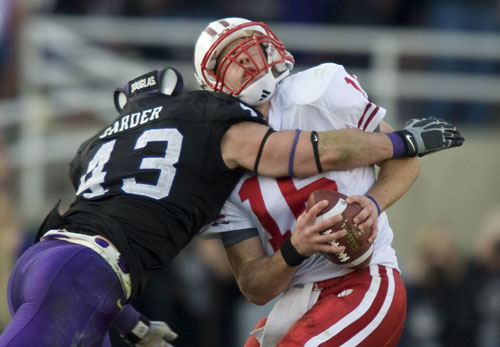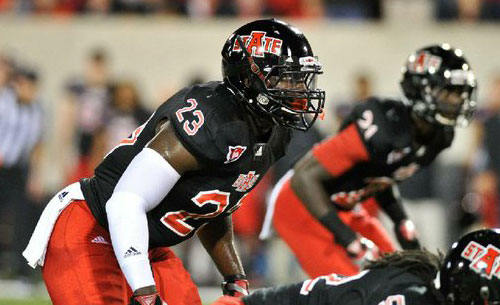Written by Kip Earlywine
Biases. We all have them. I’ve been a big Washington Huskies fan for over twenty years. Naturally, that is going to impact how I view Husky players that transition to the NFL, though it may not always the way you’d expect. Watching four years of Jake Locker made me painfully aware of his shortcomings (I listed 17 bullet points in his weaknesses section) and compared him to Vince Young. Previously, I had compared him to Jake Plummer. Not exactly glowing comparisons. I didn’t rule out 1st round potential for Locker, but I’d like to think that my evaluation was a sober one. Which I think says a lot given that Jake Locker’s legacy at Montlake was legendary.
I was also a skeptic of linebacker Mason Foster, and rolled my eyes when I heard the common assertion that he was the Huskies top senior (over Locker). I wasn’t the biggest fan of running back Louis Rankin. I’ve also been a skeptic this year of defensive tackle Alemeda Ta’amu and offensive tackle Senio Kelemete. Ta’amu made very few splash plays and was a part of the worst defense in school history (possibly the worst run defense in school history as well). Senio Kelemente didn’t stand out among his peers on what was one of the worst offensive lines in the conference. I wish them the best as Husky alums, but I don’t want them anywhere near my Seattle Seahawks, unless it’s because they are starting for the other team.
Really, the only Huskies player I can think of that I liked more than most coming out of school in recent times was Donald Butler, who’s become a solid and improving inside linebacker for the San Diego Chargers. Not bad value for a 3rd round pick. To be honest, it’s bugged me for a long time that Mason Foster was a draft darling and Donald Butler wasn’t. Foster made some amazing plays, but he wasn’t the game in, game out “heart of the defense” kind of player that Butler was.
Well today, I’m going to increase that list of one Husky player to two, because Chris Polk has impressed me over the last 3 years more than almost any other Husky player in all my years of watching UW football. Nothing wins me over faster than a player who exceeds my expectations or provides consistent quality play, and Polk did both of those things week in and week out for almost his entire college career. Polk might just be the most under-rated running back of this draft class, as you’d have to watch him every week and see his impact on the flow of the offense to truly understand his value.
 Before I get started breaking Polk down, it needs to be pointed out that of all the top running backs in this draft, Polk played behind by far the worst offensive line. Too many times, Polk met defenders in the backfield from poor blocking, but used his unique tackle breaking skill set and excellent instincts to turn negative plays into positive ones. That Chris Polk is even in the discussion with guys like Lamar Miller or Doug Martin who played behind excellent lines says a lot about Polk’s abilities. Despite having a weak line, Polk came just 57 yards shy of becoming Washington’s all time leading rusher, and the one guy who beat him (who had a very solid NFL career) did so behind a much better line back when the Huskies were fringe national title contenders.
Before I get started breaking Polk down, it needs to be pointed out that of all the top running backs in this draft, Polk played behind by far the worst offensive line. Too many times, Polk met defenders in the backfield from poor blocking, but used his unique tackle breaking skill set and excellent instincts to turn negative plays into positive ones. That Chris Polk is even in the discussion with guys like Lamar Miller or Doug Martin who played behind excellent lines says a lot about Polk’s abilities. Despite having a weak line, Polk came just 57 yards shy of becoming Washington’s all time leading rusher, and the one guy who beat him (who had a very solid NFL career) did so behind a much better line back when the Huskies were fringe national title contenders.
With excellent balance, a high-knee running style, and the rare dual ability to either power through tackles or slip through them, Polk was the perfect back for Washington’s troubled running game. A lot of Huskies fans think that Polk’s departure will not matter much as his successor Bishop Sankey has talent (he’s a Leon Washington clone), but I’ll believe it when I see it. Polk was the secret MVP of the Steve Sarkisian era. Just twice out of thirteen games last year did a defense hold Polk under 4 yards a carry. Just three times out of thirteen games did a defense hold Polk under 100 rushing yards. Polk may not rip off big touchdown runs with regularity, but his ability to consistently produce positive plays adds up in a hurry. He was the very heartbeat of Sarkisian’s version of the West Coast offense, which is designed to have the pass set up the run. That’s not easy to do when your offensive line gets beat all the time, but Chris Polk made it work anyway.
As if that rushing production wasn’t impressive enough, Polk chipped in with 332 receiving yards and 4 receiving touchdowns, including a 70 yarder on a go route. Polk can run vertical routes as well or better than most receivers do, which I probably don’t have to tell you is exceedingly rare. Over the last decade you can count the number of franchise running backs with that ability on one hand. Polk has outstanding concentration and presence of mind in addition to having terrific hands. In my opinion, Polk is the best receiver at running back since Reggie Bush, although Bush was a very different type of receiving threat. Polk is a unique weapon as a receiver and Steve Sarkisian only just began to tap into that during Polk’s final season.
Polk has deceptively solid speed. He has no shortage of touchdowns over 40 yards the last several seasons. I expect them to become less common at the NFL, but Polk’s field speed is pretty much identical to Doug Baldwin’s, and we’ve seen Baldwin outrun defenses to the end zone last year. Polk ran an unofficial 4.46 forty followed by an unofficial 4.57 at the combine, which somehow became an official 4.57 time. He posted an unofficial 4.45 at his pro day (4.49 official). The site that I use to track combine numbers lists Polk’s forty time at 4.45. In order to remain consistent (I used the same table for everyone else), I included their (fast) time in concert with Polk’s (slow) official combine time. I think the truth is somewhere in between. When healthy and in shape, Chris Polk is probably a 4.50 forty kind of guy, which just happens to be NFL average among wide receivers. In the end, I didn’t list Polk’s speed as either a strength or a weakness. It’s neither. It’s neither a weapon nor a hindrance.
Polk is a natural back who tends to make the most of his chances. He knows when to dive for two yards when trying something more heroic would probably lead to a two yard loss. Despite having a less than imposing stature, Polk is eager to drive a shoulder into would be tacklers and push for the extra yard or two. Unlike most physical runners, Polk runs with a high center of gravity very similar to Golden Tate, which allows him to keep his knees high and churn his legs through tough sledding. Like Tate, Polk has a strong sense of balance and can keep plays going for extra yards. Outside of Trent Richardson, Polk appears to be the best yards after contact back in the draft because of this trifecta of tackle breaking traits. Polk can power through a tackle but he can also slip through them too.
Polk excels at generating positive yardage almost every time he touches the ball, and he rarely fumbles. He’s an ideal back for a ball control styled offense, particularly one that runs a zone blocking scheme and has an appreciation for the deep ball. As such, I expect teams like Seattle or Green Bay to have serious interest in his skill set.
On the downside, Polk has never developed into a good pass blocker even with his strength and high effort. Despite having nice size (his playing weight last year was 222 pounds) Polk has a soft physique to the naked eye: he doesn’t look cut the same way that pretty much every other top running back looks. I don’t care about that, but I could see how that could bother GMs who are less familiar with Polk and could make judgements about athleticism based on his appearance. Polk also had a pair of shoulder injuries/surgeries during his Huskies career, most recently in January of 2010. It might be asked how much a shoulder injury matters to a running back, but for a physical back like Polk with receiving skills, it might matter a bit more than not at all.
As a final critique to Polk, I’d point out that while his performances are very consistent, his speed isn’t. Maybe his worst game last year was his final game against Baylor. Thankfully, Baylor has a terrible defense which allowed Polk to amass 147 yards and a long touchdown, but truth be told, he looked slow and stiff that game. There will be games here and there where Polk looks like he’d lose to David Hawthorne in a footrace. They are rare instances, but I’d be lying if I said they didn’t concern me at all.
In conclusion:
How highly you think of Polk will directly correlate to what you value from a running back. Do you value first downs or big plays? Do you value pass catching or pass blocking? For a team that wants a Clinton Portis type, it’s not hard for me to see them grading Polk in the 4th or 5th round. For a team that is looking for an Arian Foster type of back, Polk could earn a much higher grade.
Speaking of which, how much does pass protection actually matter for a running back? Probably a decent amount. But consider something. Here is a list of the best and worst pass blocking running backs in 2010. Here are the 15 worst rated pass blockers:
| 1 | Ray Rice | BLT | 132 | 17 | 10.61 |
| 2 | Adrian L. Peterson | MIN | 76 | 9 | 9.21 |
| 3 | Chris D. Johnson | TEN | 85 | 10 | 9.12 |
| 4 | Knowshon Moreno | DEN | 69 | 8 | 9.06 |
| 5 | Le’Ron McClain | BLT | 103 | 11 | 8.98 |
| 6 | Ricky Williams | MIA | 95 | 10 | 8.68 |
| 7 | Ryan Torain | WAS | 62 | 6 | 8.47 |
| 8 | Mike Goodson | CAR | 65 | 6 | 8.08 |
| 9 | Steven Jackson | SL | 110 | 9 | 6.59 |
| 10 | Keiland Williams | WAS | 87 | 7 | 6.32 |
| 11 | Tim Hightower | ARZ | 119 | 9 | 6.30 |
| 12 | Arian Foster | HST | 120 | 10 | 6.25 |
| 13 | LaDainian Tomlinson | NYJ | 126 | 10 | 6.15 |
| 14 | Lousaka Polite | MIA | 109 | 8 | 5.96 |
| 15 | Marcel Reece | OAK | 74 | 5 | 5.74 |
That’s not a bad list of running backs, particularly the top 3. Baltimore, Minnesota, and Tennessee have the three worst pass blocking backs in the league, but they aren’t exactly fretting about it since those backs bring so much else to the table. I don’t mean to diminish the value of pass blocking, but at the same time, it’s clearly something that can be overcome by strong contributions in other areas.
Polk is a unique player that has drawn a variety of comparisons. Some compare him to Golden Tate because the physique, balance, high center of gravity and ability to generate yards after contact are so similar. Some have compared him to Ricky Watters, who like Polk was a rare case of being a high school wide receiver that converted to running back in college. Though we all remember Watters as a thick and beasty runner, he was actually a slim physique guy with an upright running style much like Chris Polk back when Watters was playing in college for Notre Dame. Watters was also a prolific receiver for a running back and had strong yards after contact. I’ve even heard some comparisons between Chris Polk and Walter Payton due to Payton’s ability to continuously churn his legs and keep his balance. More than a few scouts have compared Polk to Corey Dillon, which I disagree with slightly but consider flattering nonetheless, as Corey Dillon was the Trent Richardson of his day and finished his career with (in my opinion) a Hall of Fame resume.
Barring injury, I think Polk is going to have a very good career, and will be an absolute steal in the 3rd or 4th round, should he last that long. I wouldn’t rule out Polk as a second round pick, even as a 2nd round pick by the Seahawks. His unique combination of talents could quietly vault him up some draft boards even as he falls on others. Given the connection Pete Carroll and Steve Sarkisian share and the fact that they both run nearly identical offenses, I see little reason to think Chris Polk couldn’t succeed for Pete Carroll after quietly being the MVP of Steve Sarkisian’s offenses the last three years. Chris Polk may not get the team on Sportscenter’s top plays as much as Marshawn Lynch does, but he’ll win you over with quality play every game, one snap at a time.
Compilation videos:
